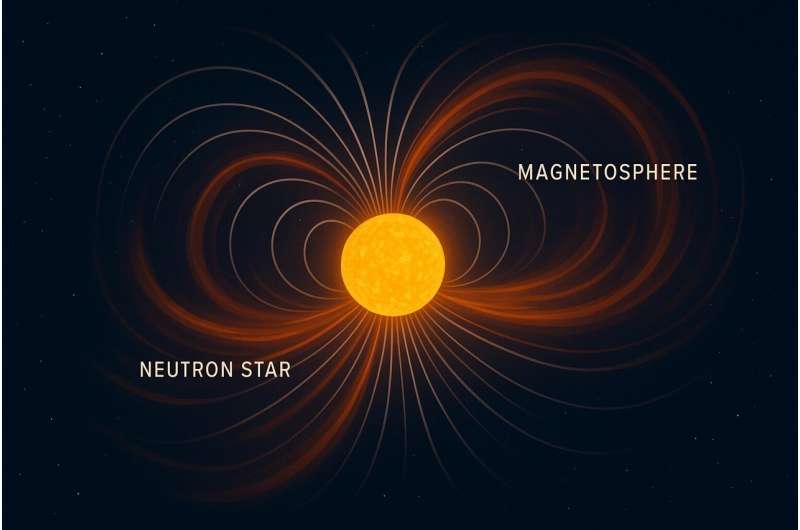"Neutron Star Magnetosphere Plasmon Effects May Impact Axion Detection Limits"

September 19, 2025
feature
by Ingrid Fadelli, Phys.org
contributing writer
edited by Sadie Harley,
reviewed by Robert Egan
scientific editor
associate editor
This article has been reviewed according to Science X's editorial process and policies. Editors have highlighted the following attributes while ensuring the content's credibility:
fact-checked
peer-reviewed publication
trusted source
proofread
Dark matter is an elusive type of matter that does not emit, reflect, or absorb light, yet is predicted to account for most of the universe's mass. As it cannot be detected and studied using conventional experimental techniques, the nature and composition of dark matter have not yet been uncovered.
One of the most promising dark matter candidates (i.e., hypothetical particles that dark matter could be made of) are axions. Theory suggests that axions could convert into light particles (i.e., photons) under specific conditions, which could in turn generate signals that can be picked up by sophisticated equipment.
In strong magnetic fields, such as those surrounding neutron stars with large magnetic fields (i.e., magnetars), the conversion of axions into photons has been predicted to generate weak radio signals that could be detected using powerful Earth-based or space-based radio telescopes.
Researchers at the Polytechnic Institute of Lisbon and other institutes recently showed that some of these radio signals could be lost before they travel across space due to interactions between axions and plasma in magnetar magnetospheres, regions around neutron stars in which magnetic fields dominate.
Their paper, published in Physical Review Letters, could inform the refinement of strategies aimed at detecting dark matter axions using radio telescopes.
'Our study started from a simple 'what if' conversation with my co-authors,' Hugo Terças, Assistant Professor at Instituto Superior de Engenharia de Lisboa and first author of the paper, told Phys.org.
'We were kicking around ideas about how axions might interact with plasmons, which are basically the collective 'waves' in a plasma. Once we realized that a conversation 'could' happen between them, the next logical step was to find the perfect place in the universe where this could play out.'
After debating about possible conditions in which axions could interact with plasma, the researchers identified the extreme environment expected to surround magnetars. This region in space, known as the magnetosphere, ultimately offered an ideal scenario in which they could test their idea.
'Imagine that previous researchers were listening for a specific note from a distant flute (the axion signal),' explained Terças.
'They calculated how loud that note should be. Our work discovered that the flute has a leak. Before the sound ever reaches us, some of the air (here, the axions) escapes through this leak into a different instrument that's muted and can't be heard (the plasmons). So, the note we're trying to hear is much quieter than anyone calculated.'
Essentially, Terças and his colleagues carried out an extensive analysis aimed at measuring the extent to which the signals associated with the conversion of axions into photons would 'leak' due to interactions with plasmons (i.e., plasma particles).
Their findings suggest that when accounting for this leak, the signals traveling across space would be much fainter than originally predicted, which means that radio telescopes would need to be far more sensitive than they are now to pick them up.
Discover the latest in science, tech, and space with over 100,000 subscribers who rely on Phys.org for daily insights. Sign up for our free newsletter and get updates on breakthroughs, innovations, and research that matter—daily or weekly.
'I believe the most exciting part of our work is how universal this underlying mechanism is,' said Terças. 'We discovered it in the extreme context of dark matter and magnetars, but it's a fundamental process that pops up all over physics. A perfect example is in nuclear fusion research, in donut-shaped reactors called tokamaks.'
'Scientists use this exact same principle to heat the plasma: they beam in electromagnetic waves, which convert into plasma waves and deposit their energy, heating the system up. It's the same physics!'
Interestingly, the plasmon interaction-related effect described by the researchers could also be relevant to other topics beyond dark matter physics. In fact, their paper offers a new framework that could shape the understanding of energy conversion across a wide range of physical systems.
'Our study shows how fundamental physics connects seemingly unrelated fields,' said Terças. 'Our big plan for future research is to flip the script entirely. Right now, the search with radio telescopes is passive—astronomers are waiting for a distant star to send us a signal. We want to move from being passive listeners to active creators.'
As part of their future work, Terças and his colleagues are also hoping to successfully realize axions inside their laboratory. To succeed in this endeavor, they would first need to create a sort of 'synthetic' plasma.
'A 'synthetic' plasma is an engineered material that mimics the extreme conditions of a magnetar's magnetosphere but on a tabletop,' added Terças.
'This would let us fine-tune the environment and essentially create the perfect conditions to coax axions into appearing through this conversion mechanism we've discovered. It's a much more direct way to hunt for them.'
Written for you by our author Ingrid Fadelli, edited by Sadie Harley, and fact-checked and reviewed by Robert Egan—this article is the result of careful human work. We rely on readers like you to keep independent science journalism alive. If this reporting matters to you, please consider a donation (especially monthly). You'll get an ad-free account as a thank-you.
More information: H. Terças et al, Resonant Axion-Plasmon Conversion in Neutron Star Magnetospheres, Physical Review Letters (2025). DOI: 10.1103/5hbb-yy48.
Journal information: Physical Review Letters
© 2025 Science X Network




